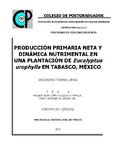| dc.description.abstract | El manejo sostenible de una plantación forestal comercial es posible con herramientas silvícolas confiables que auxilien en la toma de decisiones. En este trabajo se evaluó la Producción Primaria Neta (PPN) y la recirculación de nutrimentos en una plantación de Eucalyptus urophylla S.T. Blake en Huimanguillo, Tabasco. Se estudiaron tres parcelas de 1000 m2 para medir la producción de biomasa, caída de hojarasca, concentración de nutrimentos en los componentes del árbol y el suelo mineral. Con esta información se estimaron los reservorios y flujos de N, P, K y Ca. La producción de biomasa total (aérea + subterránea) a los siete y ocho años de edad fue de 119 y 143 Mg ha-1, respectivamente. A los ochos años de edad la plantación almacenó 348, 29, 20 y 143 kg ha-1 de N, P, K, y Ca en componentes aéreos y subterráneos, respectivamente. El incremento anual de biomasa fue de 24.27 Mg ha-1 año-1, que se traduce en una tasa anual de captura de carbono de 13.21 Mg ha-1. Para lograr este crecimiento se requiere de 73.7, 5.4, 3.2 y 41.8 kg ha-1 año-1 de N, P, K y Ca respectivamente. La caída de hojarasca fue de 3.25 Mg ha-1 año-1, a través de la cual los árboles retornan al suelo 21.9, 1.5, 1.1 y 20.2 kg ha-1 año-1 de N, P, K y Ca, en el mismo orden. La mayor cantidad de biomasa y nutrimentos se almacenó en el fuste que representó el 86 % de la biomasa total. Las hojas y ramas representaron 12.84 % de la biomasa total. Sin embargo, retirar estos compartimentos al momento de la cosecha afecta negativamente los almacenes de N y P en el sistema, comprometiendo la productividad del sistema en rotaciones subsecuentes. _______________ NET PRIMARY PRODUCTION AND NUTRIENT DYNAMICS IN AN Eucalyptus urophylla PLANTATION IN TABASCO, MEXICO. ABSTRACT: Sustainable management of a commercial forest plantation is a possible goal when trustable silvicultural tools are used to make decisions. In this study we evaluated the Net Primary Production (PPN) and nutrient cycling in a plantation of Eucalyptus urophylla S.T. Blake in Huimanguillo, Tabasco. Three 1000 m2 were measured to quantify biomass production, litter fall, and nutrient concentration in the tree components and mineral soil. With the data obtained, N, P, K, and Ca pools and fluxes were estimated for the system. Production of total biomass (above + belowground) at seven and eight years of age was 119 and 143 Mg ha-1, respectively. At age eight, the plantation stored 348, 29, 20, and 143 Kg ha-1 N, P, K, and Ca, respectively. Annual biomass increment was 24.27 Mg ha-1 y-1, which gives an annual carbon sequestration rate of 13.21 Mg ha-1. To achieve such a growth rate, 73.7, 5.4, 3.2, and 41.8 Kg ha-1 y-1 of N, P, K, and Ca, respectively, are needed. Litter fall was 3.25 Mg ha-1 y-1, and this process transferred 21.9, 1.5, 1.1, and 20.2 Kg ha-1 y-1 of N, P, K, and Ca into soil. Most biomass and nutrients were stored in stem, which comprised 86 % of total biomass. Foliage and branches comprised 12.84 % of total biomass. Harvesting of these components presumably negatively affects N and P pools, thus compromising the system productivity in future rotations. | es_MX |


